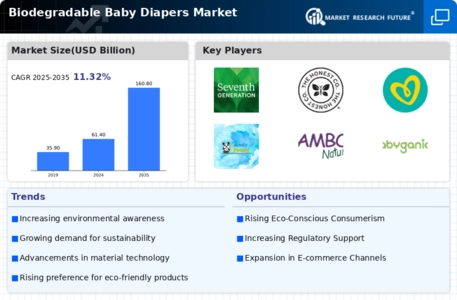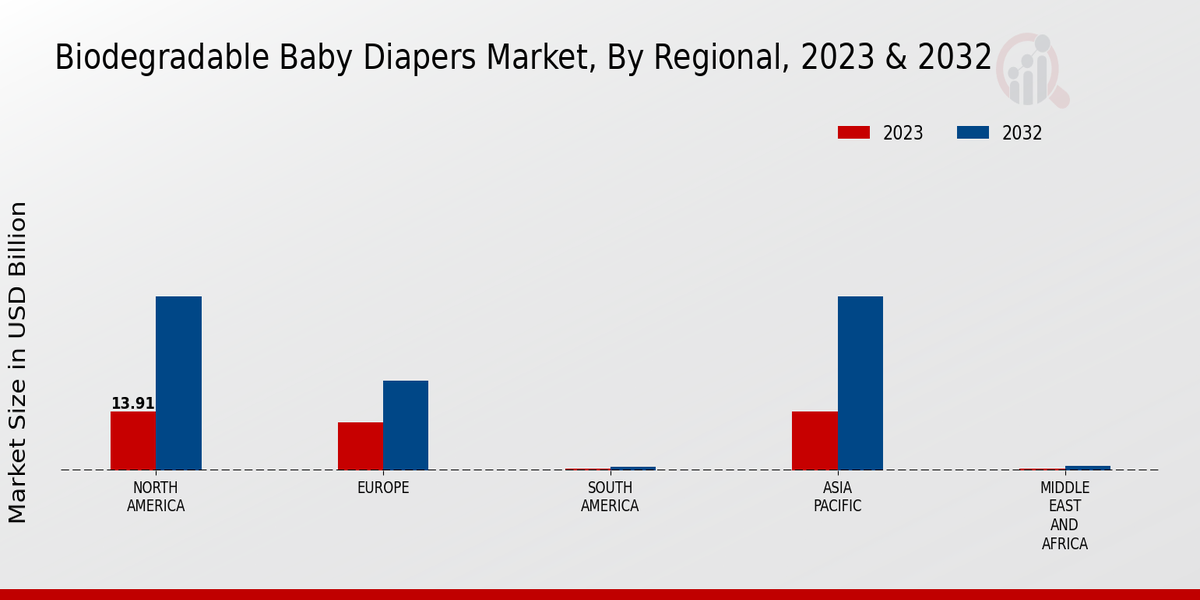Market Growth Projections
The Global Biodegradable Baby Diapers Market Industry is on a promising growth trajectory, with projections indicating a market size of 61.4 USD Billion in 2024 and an anticipated increase to 160.8 USD Billion by 2035. This growth is underpinned by a compound annual growth rate (CAGR) of 9.16% from 2025 to 2035. Such figures illustrate the increasing demand for biodegradable options as consumers become more environmentally conscious. The market's expansion is likely to attract new entrants and stimulate competition, further driving innovation and improving product offerings in the biodegradable diaper segment.
Changing Consumer Preferences
The Global Biodegradable Baby Diapers Market Industry is witnessing a shift in consumer preferences, with an increasing number of parents opting for biodegradable options over traditional diapers. This trend is largely driven by a desire for safer, non-toxic products for infants, as well as a commitment to reducing environmental footprints. Parents are actively seeking out brands that prioritize sustainability and transparency in their manufacturing processes. This evolving consumer behavior is likely to propel the market forward, as companies adapt their offerings to meet these new demands and capitalize on the growing segment of eco-conscious consumers.
Rising Environmental Awareness
The Global Biodegradable Baby Diapers Market Industry is experiencing a surge in demand driven by increasing environmental awareness among consumers. Parents are becoming more conscious of the ecological impact of traditional disposable diapers, which contribute significantly to landfill waste. Biodegradable alternatives are perceived as a more sustainable choice, aligning with the values of eco-conscious families. This shift is reflected in market growth, with the industry projected to reach 61.4 USD Billion in 2024. The growing preference for environmentally friendly products suggests that manufacturers will need to innovate continuously to meet consumer expectations.
Government Regulations and Initiatives
Government regulations promoting sustainability are playing a crucial role in the Global Biodegradable Baby Diapers Market Industry. Many countries are implementing stricter guidelines regarding waste management and the use of non-biodegradable materials. For instance, some regions are incentivizing the production and consumption of biodegradable products through subsidies and tax breaks. These initiatives not only encourage manufacturers to invest in biodegradable diaper technology but also educate consumers about the benefits of such products. As a result, the market is likely to expand, with projections indicating a growth to 160.8 USD Billion by 2035.
Technological Advancements in Materials
Innovations in materials science are significantly influencing the Global Biodegradable Baby Diapers Market Industry. The development of new biodegradable polymers and absorbent materials enhances the performance and comfort of diapers while ensuring they decompose more efficiently. For example, advancements in plant-based materials and compostable components are becoming more prevalent, appealing to environmentally conscious consumers. This technological progress not only improves product quality but also addresses concerns regarding the durability and effectiveness of biodegradable options. As a result, the market is expected to grow at a CAGR of 9.16% from 2025 to 2035.
Increased Investment in Sustainable Products
Investment in sustainable product development is a key driver for the Global Biodegradable Baby Diapers Market Industry. As awareness of environmental issues rises, investors are increasingly funding companies that focus on eco-friendly products. This influx of capital enables manufacturers to enhance their research and development efforts, leading to the creation of innovative biodegradable diaper solutions. The financial backing not only supports product development but also aids in marketing efforts to educate consumers about the benefits of biodegradable diapers. Consequently, this trend is expected to contribute to the market's robust growth trajectory.




















Leave a Comment